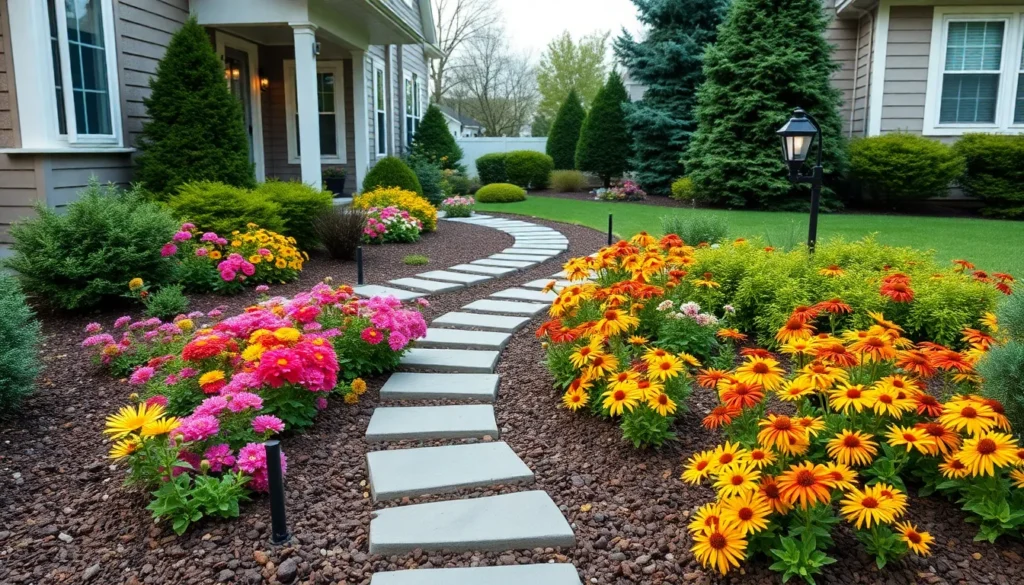Your front yard creates the first impression guests have of your home, but transforming it doesn’t require a massive budget or professional expertise. We’ve discovered that stunning curb appeal comes from smart, simple choices that anyone can carry out over a weekend.
Many homeowners feel overwhelmed by landscaping projects, thinking they need elaborate designs or expensive materials to make an impact. That’s simply not true. We’ll show you how basic elements like strategic plant placement, defined pathways, and focal points can dramatically enhance your home’s exterior appeal without very costly.
Whether you’re working with a small space or dealing with challenging conditions like shade or slopes, we’ve got practical answers that deliver maximum visual impact. These simple front yard landscaping ideas will help you create an inviting entrance that boosts your home’s value and makes you proud every time you pull into your driveway.
Create a Welcoming Pathway With Easy-to-Install Materials
Building an attractive pathway doesn’t require expensive contractors or complex installation processes. We can transform our front yard entrance using affordable materials that deliver immediate visual impact.
Use Gravel or Stepping Stones for Low-Maintenance Options
Gravel pathways offer one of the most budget friendly landscaping answers available today. We can install a 3-foot-wide gravel walkway for under $200 in most cases, using materials like pea gravel, decomposed granite, or crushed stone. These materials require minimal preparation beyond basic excavation and edging installation.
Stepping stones provide another excellent low maintenance pathway option that works well in various yard styles. We recommend placing stones 18-24 inches apart for comfortable walking distance, using materials like flagstone, concrete pavers, or natural river rocks. Installation typically takes just one weekend and doesn’t require special tools or skills.
Both gravel and stepping stone paths naturally handle water drainage better than solid concrete walkways. We find these materials particularly effective in areas with heavy rainfall or poor soil drainage, as they allow water to permeate naturally into the ground below.
Add Solar Lighting Along the Path for Evening Appeal
Solar pathway lights enhance our front yard’s safety and visual appeal without increasing electricity costs. We can purchase quality solar lights for $15-30 each and install them in minutes by simply pushing them into the ground along our pathway edges.
Spacing lights every 6-8 feet creates optimal illumination coverage for most residential walkways. We recommend choosing lights with warm white LEDs rather than cool white options, as they create a more welcoming atmosphere for evening visitors.
Modern solar lights now offer 8-12 hours of continuous lighting after full day charging, making them reliable even during shorter winter days. We suggest selecting models with automatic dusk-to-dawn sensors to eliminate the need for manual operation or timers.
Plant Low-Maintenance Shrubs for Year-Round Structure
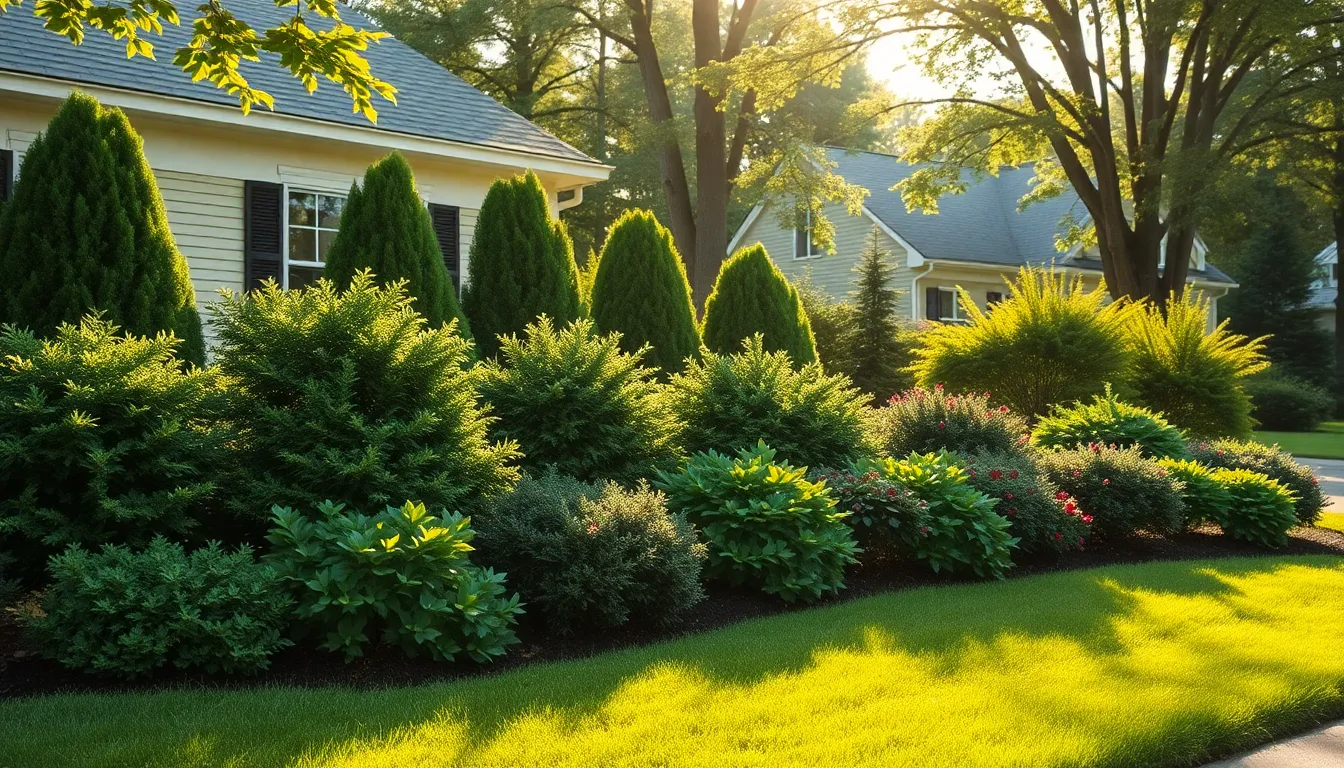
We recommend incorporating shrubs that provide consistent structure throughout all seasons while requiring minimal upkeep. These plants form the backbone of successful front yard landscaping by offering reliable visual interest year round.
Choose Native Evergreen Varieties for Consistent Color
Native evergreen shrubs maintain their foliage throughout all seasons, ensuring your front yard looks polished even during winter months. We suggest selecting boxwood or holly varieties since they’re versatile, hardy, and naturally adapted to local growing conditions. These species require less watering, fertilizing, and pest management compared to non-native alternatives.
Evergreen selections provide consistent color that anchors your industry design when other plants go dormant. We find that native varieties typically establish faster root systems and show better resistance to local weather extremes. Popular choices include dwarf varieties that won’t outgrow their intended space, saving you from frequent pruning tasks.
Local nurseries often stock region-exact evergreen options that thrive in your area’s soil type and climate patterns. We recommend consulting with staff to identify which native evergreens perform best in your exact growing zone and sun exposure conditions.
Group Plants in Odd Numbers for Natural Visual Balance
Arranging shrubs in groups of three, five, or seven creates more natural looking landscapes that avoid the formal symmetry of even numbered plantings. We use this odd number principle because it mimics how plants naturally cluster in wild settings, making your designed space feel more organic.
Odd groupings add visual depth and prevent your front yard from appearing too structured or artificial. We suggest starting with three shrubs of the same variety, spacing them at varying distances to create natural flow rather than rigid geometric patterns.
This planting technique works especially well when you’re working with different plant heights within each grouping. We find that mixing one tall shrub with two shorter companions creates ever-changing visual triangles that draw the eye naturally across your industry design.
Design Colorful Flower Beds With Seasonal Blooms
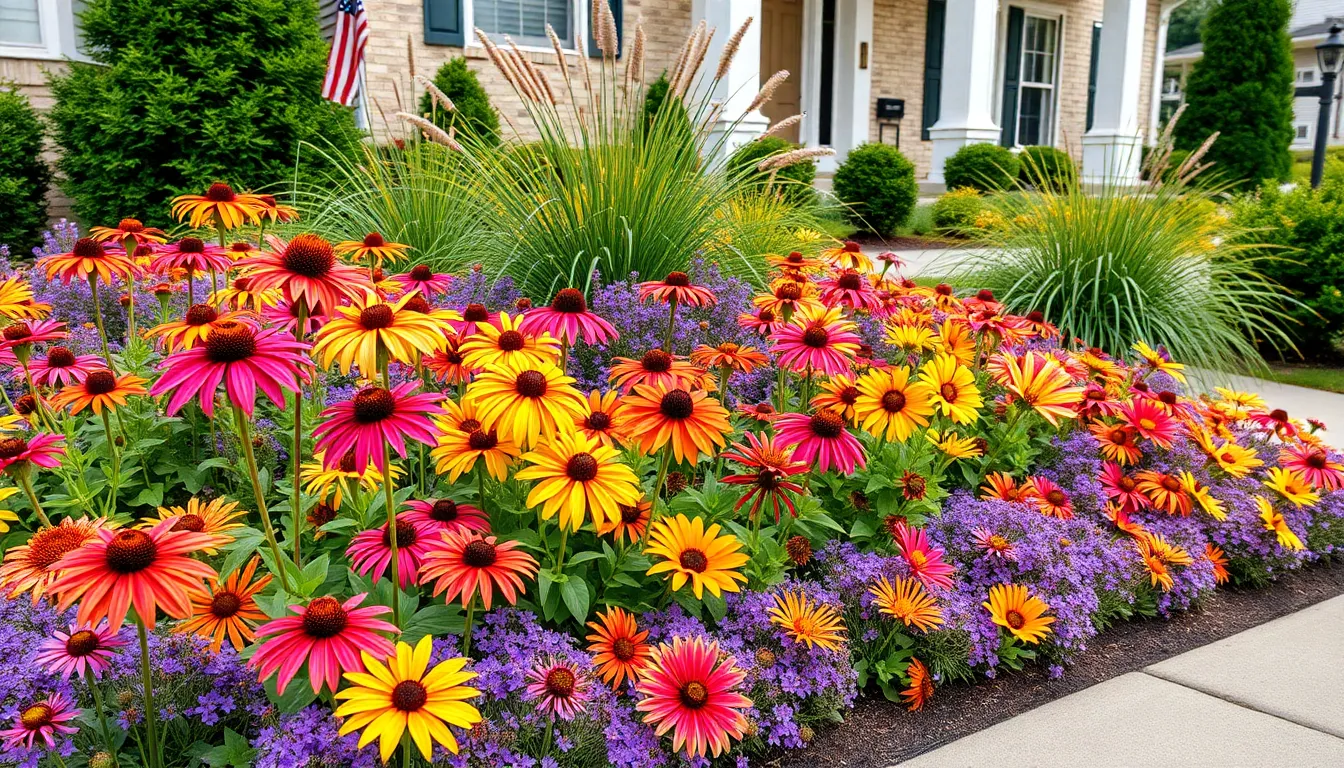
Creating vibrant flower displays transforms any front yard into a welcoming showcase that catches every visitor’s eye. We’ll show you how strategic planting choices deliver continuous color from spring through fall.
Select Perennials That Return Each Year
Perennials form the backbone of successful flower beds because they eliminate the annual replanting cycle while providing reliable beauty. We recommend starting with hardy varieties like coneflowers, black-eyed susans, and daylilies that establish strong root systems and multiply naturally over time.
Coneflowers bloom from midsummer through early fall with vibrant purple, pink, or white petals that attract butterflies and beneficial pollinators. Black-eyed susans produce cheerful yellow blooms from July through September and spread gradually to fill empty spaces without becoming invasive. Daylilies offer the longest blooming season with flowers appearing from late spring through summer in colors ranging from soft yellow to deep burgundy.
These perennial powerhouses require minimal maintenance once established and actually improve with age as their root systems strengthen. Most varieties need only annual spring cleanup and occasional division every three to four years to maintain peak performance.
Mix Heights and Textures for Ever-changing Visual Interest
Layering plants at different heights creates depth and prevents flower beds from looking flat or monotonous. We suggest placing tall grasses and shrubs in the back, medium-height flowering plants in the middle, and low-growing ground covers along the front edge.
Ornamental grasses like fountain grass or feather reed grass provide vertical structure and gentle movement that contrasts beautifully with broad-leafed perennials. Medium-height shrubs such as spirea or weigela add woody texture while producing seasonal flowers that complement herbaceous plants. Low-growing options including creeping phlox or lamb’s ear create soft edges and fill gaps between larger specimens.
Texture variety enhances visual appeal by combining smooth leaves with fuzzy foliage, broad surfaces with narrow blades, and matte finishes with glossy appearances. This layered approach mimics natural plant communities while ensuring every plant receives appropriate sunlight and growing conditions based on its mature size.
Install Mulched Areas to Reduce Lawn Maintenance
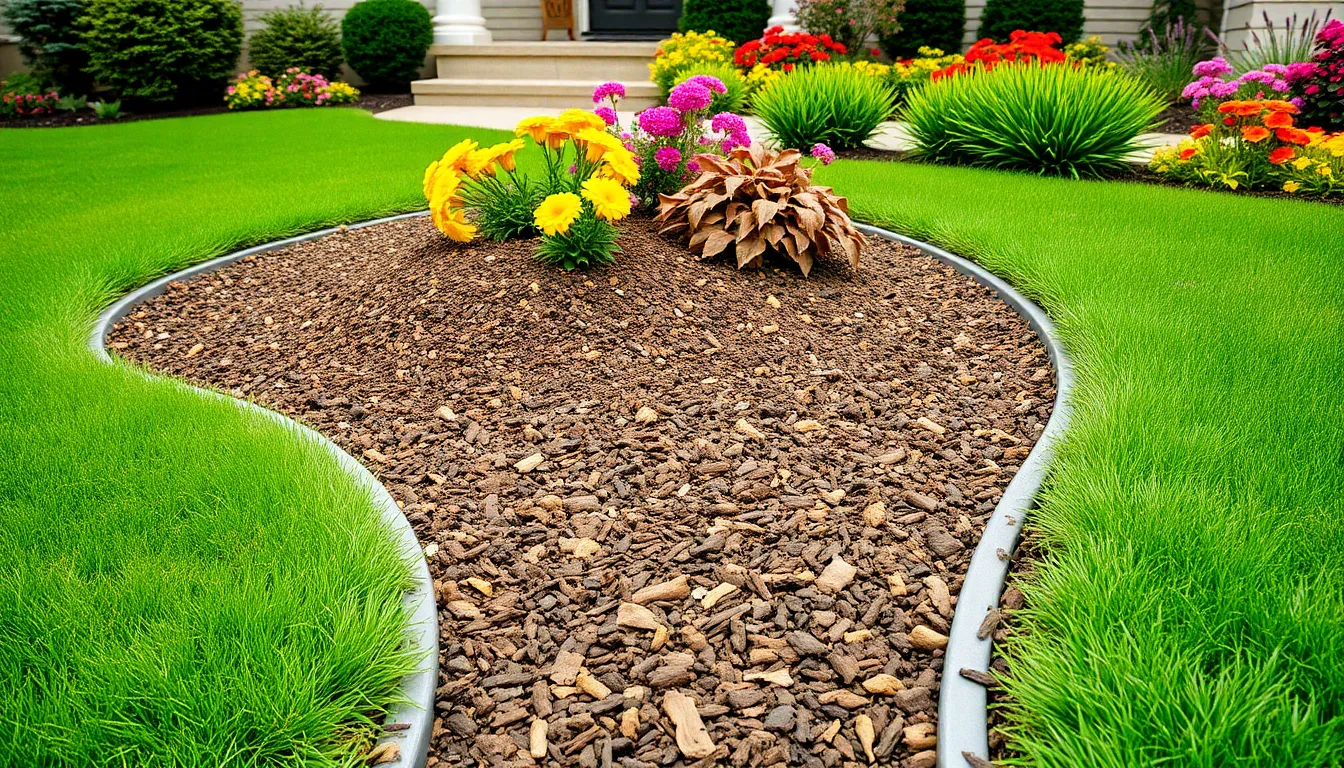
Mulched areas serve as one of the most effective ways to reduce ongoing yard work while creating a polished, professional appearance. These low maintenance zones eliminate the need for constant mowing, watering, and fertilizing that traditional grass requires.
Use Organic Mulch to Suppress Weeds Naturally
Organic mulch creates a natural barrier that blocks sunlight from reaching weed seeds, preventing germination without harsh chemicals. Wood chips, shredded leaves, and bark mulch form dense layers that inhibit weed growth by cutting off the light source these unwanted plants need to sprout.
Beyond weed suppression, organic mulch retains soil moisture by reducing evaporation rates, which means we’ll water less frequently during dry periods. This moisture retention becomes especially valuable during summer months when water bills typically spike. Decomposing organic materials also enrich the soil over time, providing nutrients to nearby plants and improving overall soil health.
Temperature regulation represents another key benefit of organic mulching. The insulating layer protects plant roots from extreme heat in summer and freezing temperatures in winter, creating a more stable growing environment. We recommend applying a 2 to 3 inch layer of organic mulch around trees, shrubs, and flower beds for optimal results.
Create Defined Borders With Simple Edging Materials
Defined borders establish clean lines between mulched areas and existing lawn, preventing grass from creeping into landscaped sections. Plastic edging strips offer an affordable solution that installs quickly with basic tools, typically costing under $50 for most front yard projects.
Metal edging provides a more durable option that withstands weather extremes and maintains sharp, professional looking lines for years. Steel or aluminum strips bend easily around curved garden beds and resist damage from lawn mowers and string trimmers. Installation requires only a rubber mallet and marking spray to achieve perfectly straight or gently curved borders.
Stone or brick edging adds visual weight and natural texture while serving the same functional purpose as synthetic materials. These materials complement both traditional and contemporary home styles, creating seamless transitions between different industry elements. Natural stone edging works particularly well with organic mulch, reinforcing the cohesive design throughout the front yard space.
Add Focal Points With Statement Plants or Decorative Elements
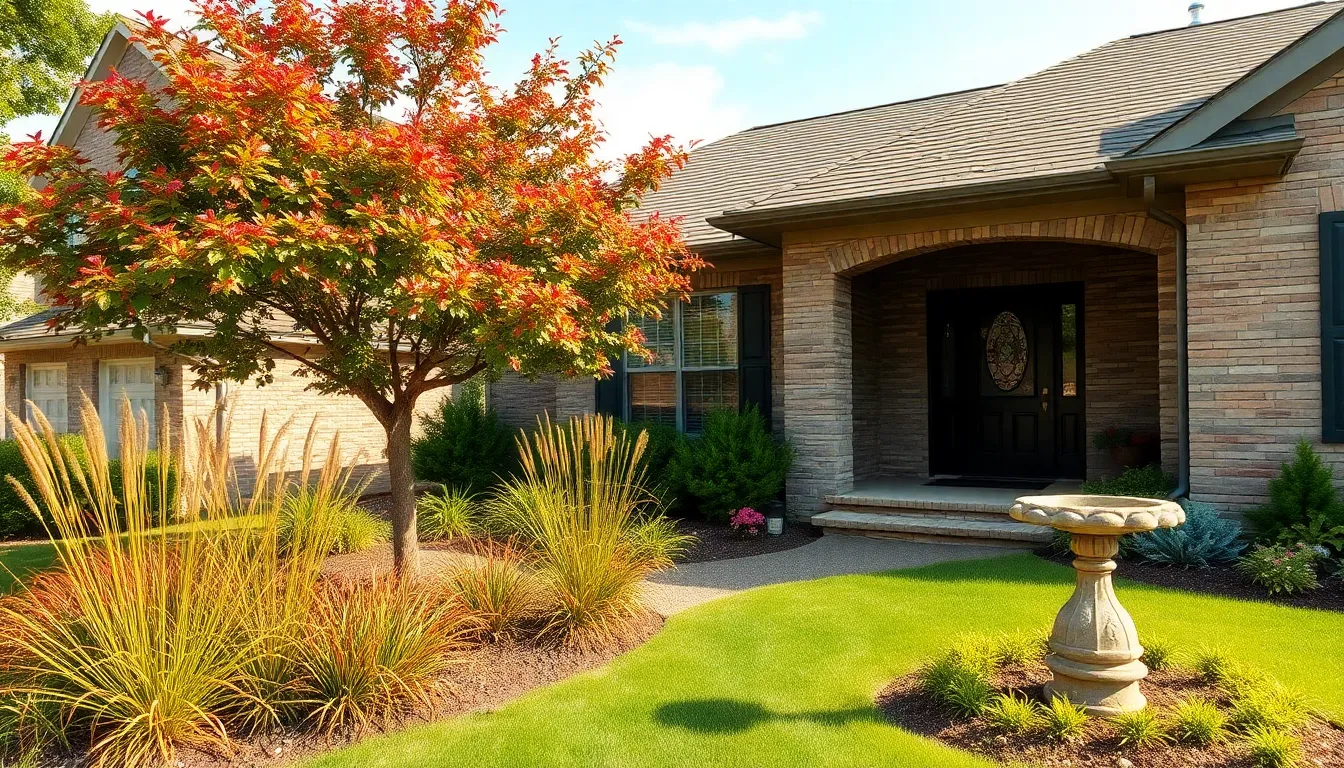
Statement plants or decorative elements create visual anchors that draw the eye and establish your front yard’s personality. These focal points transform ordinary spaces into memorable landscapes that boost curb appeal instantly.
Choose One Large Tree or Ornamental Grass as an Anchor
Selecting a single large tree or clump of ornamental grass serves as your industry’s foundation piece. We recommend positioning this anchor element off center rather than directly in front of your home to create a more natural and visually appealing composition. Ornamental grasses like fountain grass or pampas grass offer year round structure while requiring minimal water and care.
Trees such as Japanese maple, dogwood, or flowering cherry provide seasonal interest through changing foliage, blooms, or bark texture. Consider the mature size when planting to ensure your chosen tree won’t overwhelm the space or interfere with power lines. Position your anchor plant where it can frame your home’s entrance without blocking windows or architectural features.
Ornamental grasses work particularly well in smaller front yards where full size trees might appear disproportionate. These grasses create movement and texture while establishing height variation in your industry design. Choose varieties that complement your climate zone and existing plant palette for the best long term results.
Incorporate Weather-Resistant Garden Art or Planters
Weather resistant garden art and planters add personality to your front yard while withstanding seasonal changes. Decorative sculptures, birdbaths, or artistic planters create conversation pieces that reflect your personal style. We suggest choosing materials like cast iron, stone, or high quality resin that can handle temperature fluctuations and moisture without deteriorating.
Large planters filled with seasonal flowers or evergreen arrangements provide flexibility to change your display throughout the year. Position these containers near your front entrance, along pathways, or clustered in odd numbered groups for maximum visual impact. Select planters with drainage holes to prevent water damage and root rot in your container plants.
Garden art pieces such as wind sculptures, decorative stakes, or stone accents work best when scaled appropriately to your yard size. Avoid overcrowding your space with too many decorative elements, as this can create visual chaos rather than focal points. Choose one or two standout pieces that complement your home’s architectural style and existing industry features.
Strategic placement of these elements near your newly mulched areas or defined borders creates cohesive design flow while highlighting your thoughtful landscaping efforts. Weather resistant materials ensure your investment maintains its beauty and function through multiple seasons.
Incorporate Raised Planters for Easy Access and Care
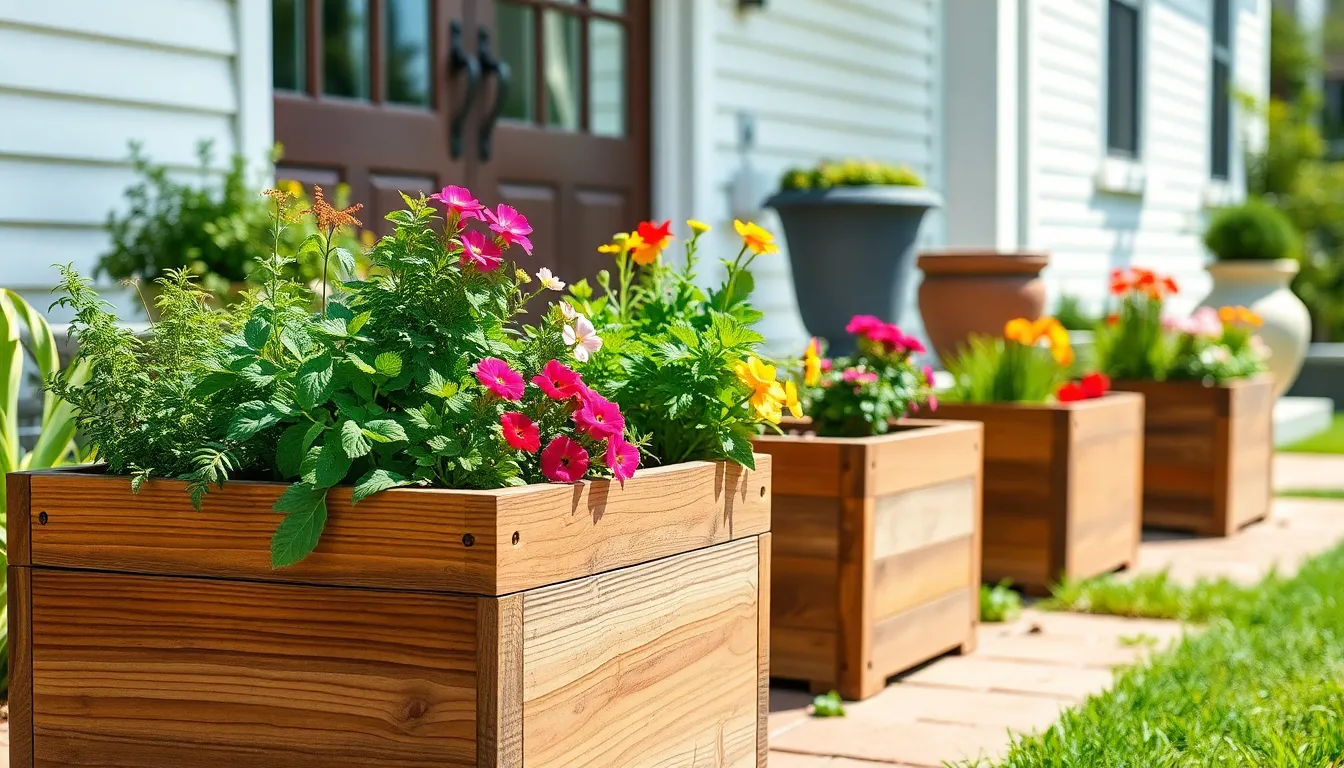
Raised planters transform your front yard maintenance routine by bringing plants to a comfortable working height. We find these elevated growing spaces particularly beneficial for gardeners who want to avoid constant bending and kneeling.
Build Simple Wooden Boxes for Herb or Flower Gardens
Building wooden planters offers an affordable solution that adds rustic charm to your industry design. We recommend using cedar or redwood for natural weather resistance, though pressure treated lumber works well for budget conscious projects. Standard dimensions of 4 feet by 2 feet with 8 to 12 inch depth accommodate most herbs and flowering annuals perfectly.
Construction requires basic tools like a drill, saw, and measuring tape to create these functional garden features. We suggest pre drilling holes to prevent wood splitting and using galvanized screws for long lasting connections. Adding drainage holes every 6 inches along the bottom prevents waterlogged soil that can damage plant roots.
Cost effective materials keep your budget under $50 per planter when purchasing lumber from local home improvement stores. We’ve found that grouping three wooden boxes creates visual impact while maintaining the odd number principle that enhances natural appeal. Filling these containers with quality potting mix ensures proper drainage and nutrient availability for healthy plant growth.
Use Containers for Flexibility in Plant Placement
Container gardening provides unmatched versatility for front yard design changes throughout growing seasons. We appreciate how moveable planters allow us to adjust layouts based on sunlight patterns, weather conditions, or simply changing aesthetic preferences. Ceramic, fiberglass, and resin containers offer durability while complementing various architectural styles.
Strategic placement of containers creates defined spaces without permanent industry alterations that might require future removal. We position larger containers near entryways to frame doorways, while smaller pots accent steps and pathway edges for cohesive visual flow. Moving containers seasonally prevents soil compaction and allows for easy plant rotation.
Weather resistant materials ensure your investment withstands seasonal temperature fluctuations and precipitation changes. We select containers with adequate drainage holes and use pot feet or saucers to protect surfaces underneath. Grouping containers in clusters of three or five creates more substantial visual impact than single scattered pots throughout the space.
Create Symmetrical Designs for Classic Curb Appeal
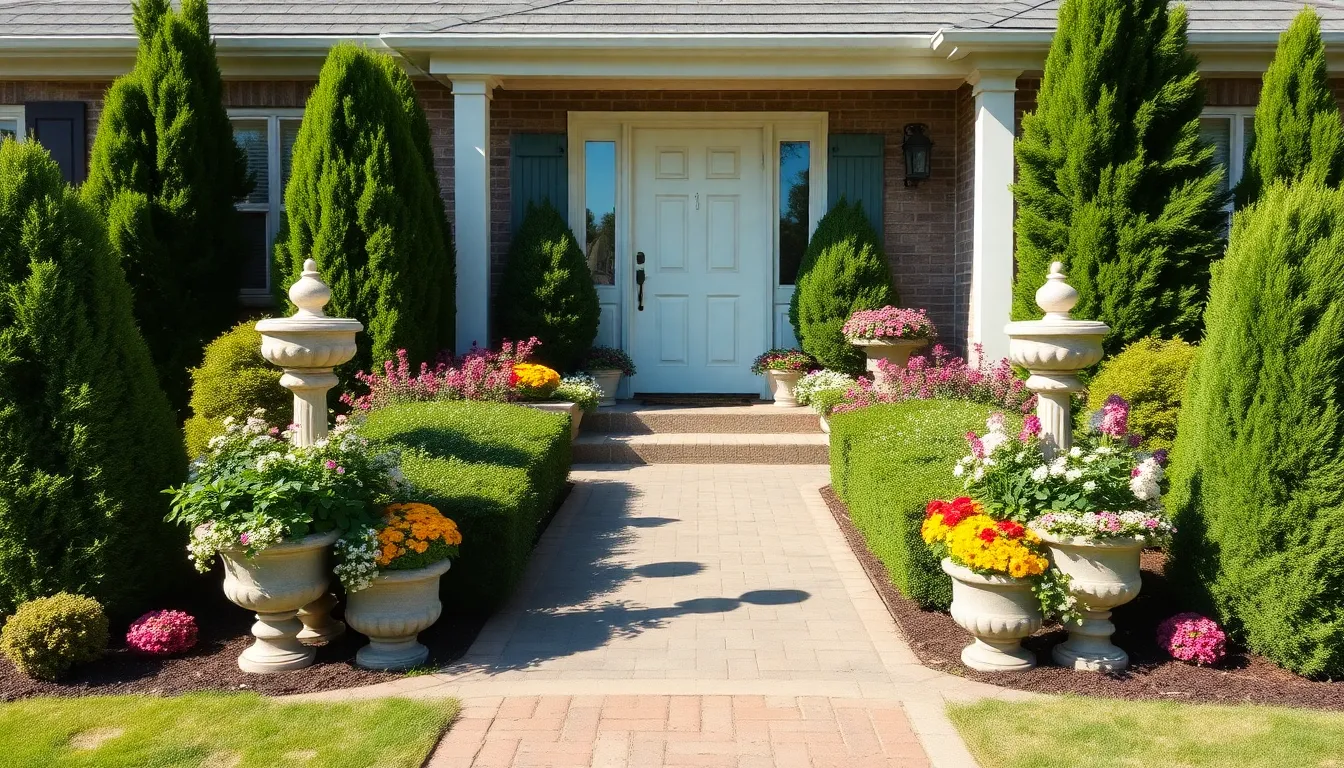
Symmetrical landscaping delivers instant visual order and elegance that guests notice immediately. This classic design approach creates balance through mirror plantings and thoughtful element placement.
Mirror Plantings on Both Sides of Your Front Door
Mirror plantings create a welcoming entrance by flanking your front door with identical elements. Position matching shrubs, flowers, or small trees on both sides of your entryway to establish immediate visual balance. We recommend selecting plants that maintain consistent size and shape throughout the growing season for best results.
Choose identical containers or planters filled with seasonal blooms like petunias or marigolds for colorful symmetry. Place matching evergreen shrubs such as boxwood or small conifers to provide year-round structure and color. Consider installing identical window boxes beneath front-facing windows to extend the symmetrical theme beyond the doorway.
Maintain consistent spacing between your mirror plantings and the front door to ensure proper proportional balance. Keep plant heights similar on both sides, trimming regularly to preserve the symmetrical appearance. Select plants with similar growth rates and maintenance requirements to make upkeep manageable.
Balance Large Elements With Matching Smaller Accents
Balance large focal points with coordinated smaller elements to create visual harmony throughout your front yard. Position substantial features like mature trees or large shrubs as anchor points, then complement them with matching decorative accents. We suggest using identical planters, garden stones, or low-growing perennials to create this balanced relationship.
Create repetition by placing matching decorative pots or urns at equal distances from your main focal points. Install identical lighting fixtures or garden ornaments to reinforce the symmetrical theme across different areas of your industry. Consider using pairs of smaller shrubs or ornamental grasses to echo larger plantings while maintaining proper scale relationships.
Maintain consistent spacing and proportional relationships between large and small elements for optimal visual impact. Edge your flower beds and pathways with matching materials like stones or bricks to define symmetrical spaces and enhance overall appeal. Select accent pieces that complement your main plantings in color, texture, and style to achieve a cohesive, polished appearance.
Establish Ground Cover Alternatives to Traditional Grass
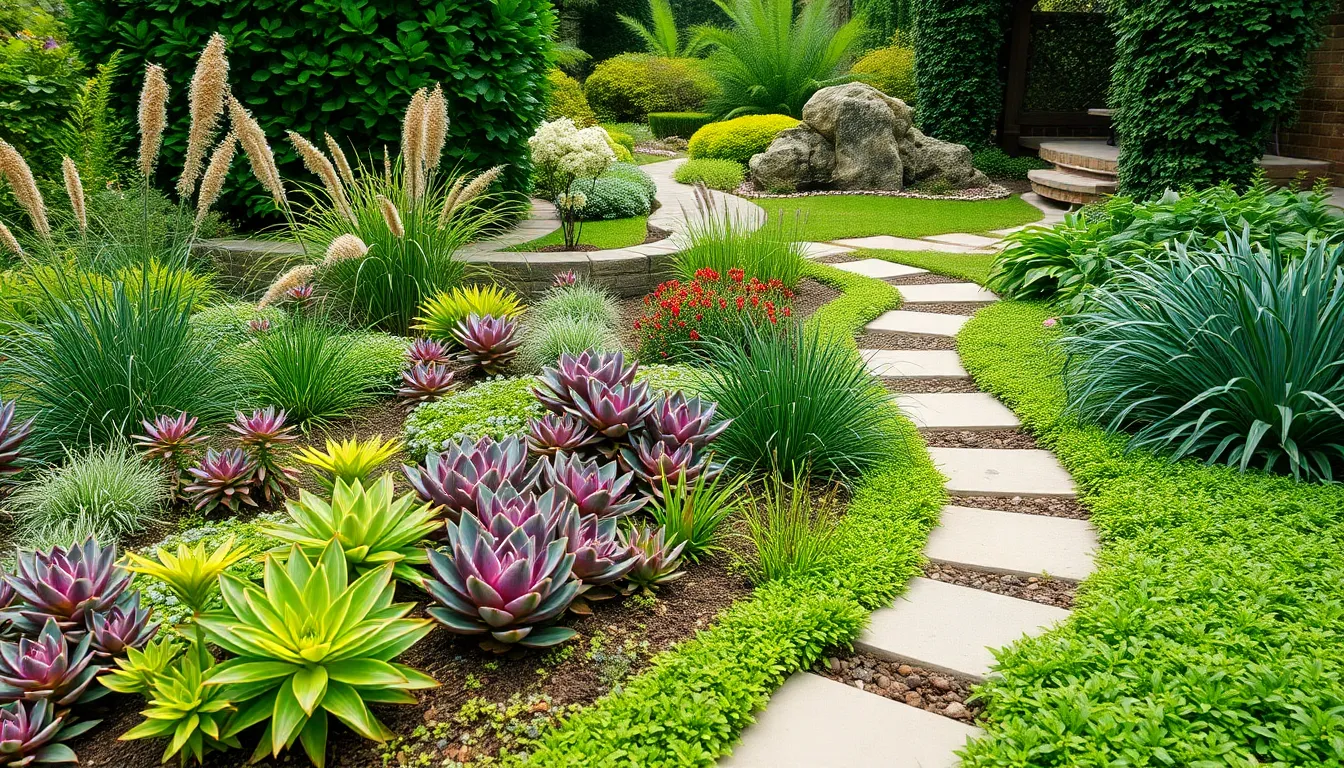
We can transform our front yards by replacing traditional grass with low maintenance alternatives that reduce upkeep while adding visual interest.
Plant Spreading Varieties That Require Minimal Water
Succulents offer exceptional drought tolerance and come in diverse shapes, colors, and textures that create stunning visual displays. These hardy plants store water in their leaves, requiring minimal irrigation once established in well-draining soil.
Ornamental grasses provide texture and movement while demanding very little water throughout the growing season. Popular varieties like fountain grass, blue fescue, and feather reed grass add architectural interest and sway gracefully in the breeze.
Creeping thyme spreads naturally to form a fragrant carpet that releases pleasant aromas when walked upon. This low-growing perennial blooms with tiny purple or white flowers and tolerates foot traffic better than traditional grass.
Sedum varieties create colorful ground cover that thrives in poor soil conditions and requires watering only during extended dry periods. These spreading perennials produce clusters of star-shaped flowers in late summer and fall.
Choose Options That Thrive in Your Climate Zone
Research your exact hardiness zone before selecting any ground cover plants to ensure they’ll survive your area’s temperature extremes and growing conditions. We recommend consulting the USDA Plant Hardiness Zone Map or speaking with local extension offices for accurate zone information.
Visit local nurseries for region-exact recommendations since they stock plants that perform well in your particular climate and soil conditions. Local garden centers understand which varieties handle your area’s rainfall patterns, humidity levels, and seasonal temperature fluctuations.
Consider native plant options that naturally evolved in your region and require less water, fertilizer, and pest control than non-native alternatives. Native ground covers support local wildlife while establishing faster and living longer than exotic species.
Test soil conditions in your yard to determine pH levels and drainage characteristics before planting any ground cover alternatives. We suggest taking soil samples to your local extension office for professional analysis and exact plant recommendations based on your results.
Conclusion
Transforming your front yard doesn’t require a massive budget or professional expertise. We’ve shown you how strategic plant choices paired with thoughtful design elements can create stunning curb appeal that reflects your personal style.
The key is starting with one or two focal areas and building from there. Whether you choose colorful perennial beds symmetrical plantings or low-maintenance ground covers each approach offers practical benefits while improving your home’s visual impact.
Remember that the best landscaping answers work with your local climate and lifestyle needs. We encourage you to experiment with different combinations of these ideas to create a front yard that welcomes guests and brings you daily satisfaction for years to come.
Frequently Asked Questions
How much does it cost to improve front yard curb appeal?
You can significantly enhance your front yard’s curb appeal on a modest budget. Simple improvements like gravel pathways and stepping stones can be installed for under $200. Raised planters cost around $50 each using weather-resistant materials. Many effective landscaping changes, such as strategic plant placement and adding mulch, require minimal investment while providing maximum visual impact.
What are the best low-maintenance plants for front yard landscaping?
Native evergreen shrubs like boxwood and holly are excellent choices as they provide year-round structure and require minimal upkeep. For colorful displays, consider perennials such as coneflowers, black-eyed susans, and daylilies. These plants are reliable, drought-tolerant once established, and provide consistent beauty throughout growing seasons without constant maintenance.
How should I arrange plants in my front yard for the best visual appeal?
Group plants in odd numbers (three, five, or seven) to create a natural, organic look that avoids rigid symmetry. Use a layered approach with tall grasses and shrubs in back, medium-height flowering plants in the middle, and low-growing ground covers in front. This creates visual depth and makes your landscape feel more inviting and harmonious.
What materials work best for creating front yard pathways?
Gravel and stepping stones are excellent, affordable options that provide effective drainage and easy installation. These materials are low-maintenance and cost-effective. Consider adding solar pathway lights spaced appropriately along your walkway to enhance safety and visual appeal during evening hours, using warm white LEDs for the best ambiance.
How much mulch should I apply around plants and trees?
Apply a 2 to 3 inch layer of organic mulch around trees, shrubs, and flower beds for optimal results. This depth effectively suppresses weeds, retains soil moisture, and regulates temperature for plant roots. Organic mulch also breaks down over time, enriching the soil naturally while reducing overall lawn maintenance requirements.
What are good alternatives to traditional grass for ground cover?
Low-maintenance alternatives include succulents, ornamental grasses, creeping thyme, and sedum. These options require minimal water and add visual interest and texture to your landscape. Choose plants that thrive in your specific climate zone and consult local nurseries for region-specific recommendations to ensure the best results.
How can I create focal points in my front yard?
Choose a single large tree or ornamental grass as an anchor, positioned off-center for a natural look. Japanese maple or flowering cherry trees provide seasonal interest, while ornamental grasses add texture and movement. Incorporate weather-resistant garden art and planters strategically to create cohesive design flow while reflecting your personal style.
Should I use symmetrical or asymmetrical landscaping design?
Symmetrical landscaping creates instant visual order and elegance, perfect for formal appearances. Use mirror plantings to flank your front door with identical elements like matching shrubs or seasonal blooms. However, asymmetrical designs can feel more natural and organic. Choose based on your home’s architectural style and personal preference for the best curb appeal.

